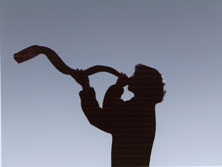 The Feast of Trumpets (Yom Teruah) falls on the first day of the seventh month, a month, the Sabbatical month of the year. It ushers in the last three annual feasts, namely, Trumpets, (Yom Teruah) Atonement (Yom Kippur) and Tabernacles (Succoth). These feasts have become known as “The High Holy Days,” marked the conclusion of the religious year and are types and pictures of the conclusion and consummation of the plan of redemption.
The Feast of Trumpets (Yom Teruah) falls on the first day of the seventh month, a month, the Sabbatical month of the year. It ushers in the last three annual feasts, namely, Trumpets, (Yom Teruah) Atonement (Yom Kippur) and Tabernacles (Succoth). These feasts have become known as “The High Holy Days,” marked the conclusion of the religious year and are types and pictures of the conclusion and consummation of the plan of redemption.
Yom Teruah and Yom Kippur go hand in hand together yet they are two totally different festivals. Neither feast is connected with any historical or national event. They are seen as universal feasts and yet they are both very personal celebrations. Yom Teruah is a time for us as individuals to prepare ourselves to stand before the judgment seat of God. Yom Kippur is a time of seeking forgiveness and cleansing.
Both feasts are observed, unlike all the other festivals; as a day of festivity and joyfulness. These two are celebrated in a spirit humility and in intense moral and spiritual introspection, soul searching, as any plaintiff would do before standing before the Supreme Judge of the universe, appealing for his life.
Yom Teruah became the second most solemn day of the Jewish religious calendar, being surpassed in importance only by Yom Kippur. The solemnity of the feast could go totally unnoticed to a casual reader of torah where the feast is simply designated as “a remembrance blast” (Lev 23:24) and “a day of blowing” (Num 29:1).
The first reference to Yom Teruah is found in Leviticus 23:24: “In the seventh month, on the first day of the month, you shall observe a day of solemn rest (Shabbat), a memorial proclamation with a blast of trumpets (Ziccaron Teruah), a holy convocation.” The Hebrew phrase ziccaron teruah can be literally translated as “a remembrance blast.”
The second major reference is found in Numbers 29:1: “On the first day of the seventh month you shall have a holy convocation; you shall do no laborious work. It is a day for you to blow the trumpets (yom teruah).” The Hebrew phrase yom teruah literally means “a day of blowing.” The crucial word in both references is teruah, a series of staccato sounds on a wind instrument. Click to Hear
If all you think when you hear the Shofar being blown is “he did that real good or that was terrible” then you have missed the whole purpose of Yom Teruah. If on the other hand as you hear the first long sound being blown and from the innermost part of your being you too are crying out to your Father in heaven “Forgive Meeeeeeeeee” or when you hear the second Staccato sound your soul is crying out to your Father in heaven “ forgive me, forgive me, forgive me, forgive me”, and with the third Staccato sound you cry out like a baby who is crying so hard he can’t catch his breath, “ forgive me, forgive me, forgive me, forgive me”, then you have done well.
Maimonides, one of the great Jewish philosophers, explained that the blowing of the shofar on Yom Teruah, is a wake up call for people to abandon their evil ways and return to God: “Awake, O you sleepers, awake from your sleep! Search your deeds and turn in repentance. O you who forget the truth in the vanities of time and go astray all the year after vanity and folly that neither profit nor save–remember your Creator! Look at your souls, and better your ways and actions. Let every one of you abandon his evil ways and his wicked thoughts and return to God so that He may have mercy upon you.”
You can celebrate by eating apples dipped in honey and pomegranates; you can celebrate the New Year, Rosh Hashanah and blow your shofar or you can you can cry out to your Father in heaven and prepare yourself to stand before your Judge and Ruler of the universe, as one appealing for his life, which is what the feast is really all about… It’s just a though.